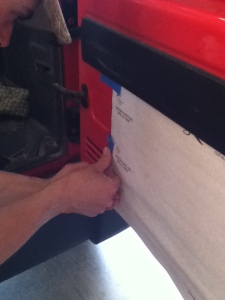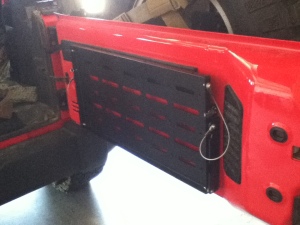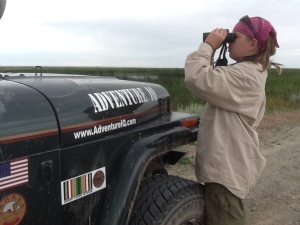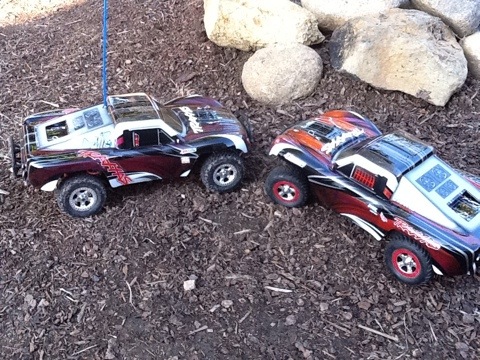
Our first weekend with the rigs…pre-modifications
There is nothing like pulling your new rig out of the box for the first time. It’s like a new-born. It even smells new. So many unknowns, especially if you are new to the RC adventure world. Like parenting, there are so many opinions out there. So many directions to take your rig.
My first piece of advise, just drive. Go have fun. As you see the need or things break, then replace the parts. Go to any hobby shop or RC event, and just like in raising kids, you get advise. I have a hard time over-looking the advise-giver’s screaming brat as I grow old of the spontaneous Parenting 101 class.

Other accessories like sand ladders not only look great, but also useful to the scale experience.
I have been asked to share modifications and upgrades I made to my SCX 10 Wrangler. While Melissa and Abby went the route of RTR (Ready-to-Run) I opted for a kit. I was not interested in a used rig since 1) every owner wants what they put into it-and they are never worth the asking price and 2) I specifically wanted a fantasy version of my new 1:1 JK Wrangler.
First, I built, well had lots of help building, OK, Troy from Team Dewey built my ride from a kit. But I did help. OK, I stayed out-of-the-way mostly. He let me do the body and put some stickers on…and the shocks…
We ordered my rig as a kit and I provided the electronics. Originally it had a Traxxas ESC, which has now been upgraded to a Castle Side Winder 3. The upgrade was based on the need to run 3S LiPo batteries. Using 3S has had its own love/hate relationship. I like the Castle since it is both waterproof and programmable. I can set everything from LiPo cut-off to braking power.
The Vanquish LED light-bar requires 3S to run. The ESC was really designed for 2S, but held well on 3S. The lights require 3S and provide enough illumination on the trail that I really don’t need a headlamp when doing night adventures. I have also used the lights on my RC to sift through the camper at night. It is seriously bright.
Another 2S/3S battle I fight is with my winch. I use the RC4WD Bull Dog. This winch has been debated to no end, specifically from the guys who crawl. I was advised against it, specifically from a local Treasure Valley shop that also earned my distrust on so many other issues. The winch is designed to run on 2S, a direct conflict with my 3S battery selection needed to power the lights. So I use a BEC from Castle to power the winch. The BEC draws power directly from the battery and places it into a usable power source for winching. RC4WD now has a new WARN winch that will handle 3S. My hopes are to get one soon to test. I really like my RC4WD winch.
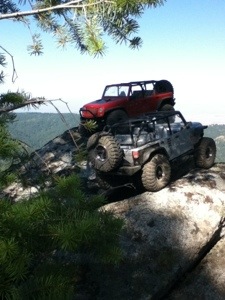
Drive stock until it breaks. By then, you will have a better idea for your needs
Why the crawling communities shy away from the winch is beyond me. All three of the AIQ rigs have one and we have yet to have any issues. They pull well, easy to use, and look great. I had push back at one point that it will lift only 6lbs. My rig weighs in at just over 6lbs. I cannot think of a situation where I would need to lift my entire rig up at 90°. If I did, well that’s what pulleys are for. I drive scale trails in scale conditions. The day I find an obstacle that is a 4x the height of my rig that I have to winch strait up, I will start doing it in the scale world. I am in this to keep it real. I don’t take my 1:10 rig over tree stumps.
Speaking of weight, that seems to be the first question I get from comp crawlers. To be honest, I don’t know, nor do I really give a rat’s hind quarters. It seems like there is some kind of weight envy out there, like these guys convert the weight of their rig to penis length. Okay, I come in at over six, but I’m happy….with rig weight that is…
For the power plant, I started out with a Thunderbolt 55T motor. I moved to a 35T because I wanted more speed on the trail and still have torque when I needed it. My wife and kiddo still have 55T on their rigs, and this summer I want to see how the rigs perform when running wide open on trails. Heat could be an issue as they drive wide open to keep up speed.

I have tested a few wheel and tire combos since getting the rig. Right now I am running RC4WD Super Swampers and very happy. They work great in sand, snow, rock, and gravel. When they get wet, they get super sticky. I have minimal wheel weights from Axial up front. Again, the comp guys swoop in for the attack…but I don’t run wheel weights on my 1:1 rig…I mainly have weight in the front of the 1:10 to simulate the weight disbursement of my 1:1. Running bead-lock wheels are from Axial.
The RC4WD winch sits happily on top of a RC4WD shorty bumper for the JK. It mimics the Rugged Ridge bumper on my 1:1 JK. Abby and Melissa are also using bumpers from RC4WD, but all three of us chose different styles.
At the heart of all that tugging power is a Pull Pal land anchor. Both Melissa and I have one. (Abby keeps saving up for one, but never gets there…) I have tested 4-5 other land anchors and the most happy with the Pull Pal.
On the back I have added a dual gas can rack from DS Pro. They build great stuff. It will also hold two shovels but they either fall out or break on a roll. No big deal, I moved the items into a new location. The team from DS Pro is awesome and they really back up their products. The stuff looks and funtions well.
I replaced my sliders with an aluminum set from BPC. I won these at a G6 and love them. The only downsides have been 1) they don’t come with compatible screws to attach the sliders to the chassis, and the Axial screws are too short to bite and hold in place and 2) The angle you have to get the driver to engage the screws is impossible to get at. I will run them until I get a custom set. I have the Castle ESC and my water-proofed radio receiver servo-tapped to each one.
Speaking of Radio, I use a Spectrum that I bought used from Troy. It has a programmable channel that I operate the winch from. I have it tied to a lanyard, which stays clipped to a D-Ring on my day pack.
This week I did add aluminum C-Hubs in the front from Axial. Testing…testing..testing…
As for Servo, I have an unknown servo I rebuilt a few years ago. When it dies, a Savox water-proof unit is going in.
Accessories include ice chest, shovels, Hi-Lift jack, sleeping bags, etc. I change this stuff out often, including a few rafts and canoes. I swear by my sand ladders from DS Pro and an MaxTraxx. I also use a yank strap that I made for getting others unstuck. I get asked how many scale points I rate….who freek’n cares! Other great items are from Awesome Action RC and Scott Anthony.
What I place on the rig depends on my groove. Taking extra batteries– add a few fuel cans… Eating lunch on the trail- throw on the ice chest- My 4-legged buddies hanging with me as I hike- yep- I even have a scale Trigger-Dog!

The crawling crowd around her scoffs the RC4WD winch, but my little rig is on the trails nearly every day and has not seen any issues to date. Here it is “winching-down” a fellow G6er
The whole thing is powered up with a flick of a huge switch in the back. The light bar also has its own power switch. Everything is double water-proofed with Plasti-Dip.

Three G6s and hundreds of hours on the trail, pretty happy with my rig
The important point is get out and enjoy your rig. At the end of the day it is a toy. Be thankful that you live someplace where you can get out and simply enjoy the outdoors and you have the means to purchase a simple hobby. Don’t get wrapped around the axle (no-pun intended) on brands, weights, points, etc. It’s about the experience.

Get out and adventure!

 Wood splitting with a survival knife- also known as batoning can add a valuable wilderness survival skill to your toolbox. This is useful because it helps you in creating smaller- easier to ignite pieces of wood even when the wood is wet. Learn with a full blade survival knife and work your way to using a small axe or hatchet.
Wood splitting with a survival knife- also known as batoning can add a valuable wilderness survival skill to your toolbox. This is useful because it helps you in creating smaller- easier to ignite pieces of wood even when the wood is wet. Learn with a full blade survival knife and work your way to using a small axe or hatchet.


